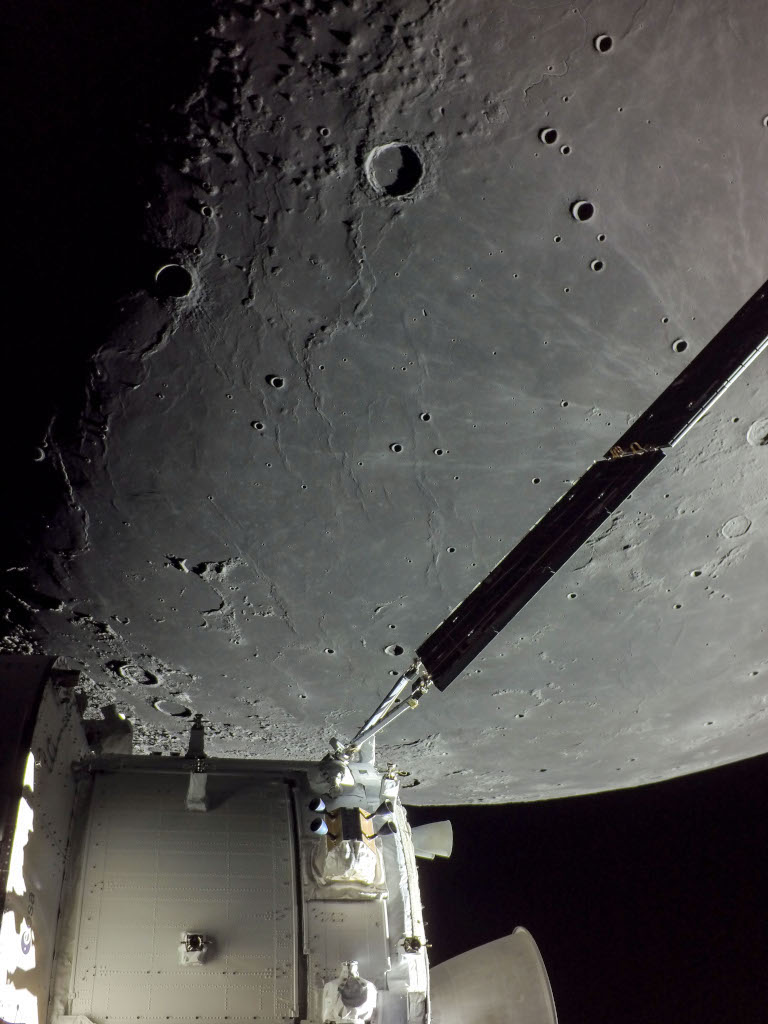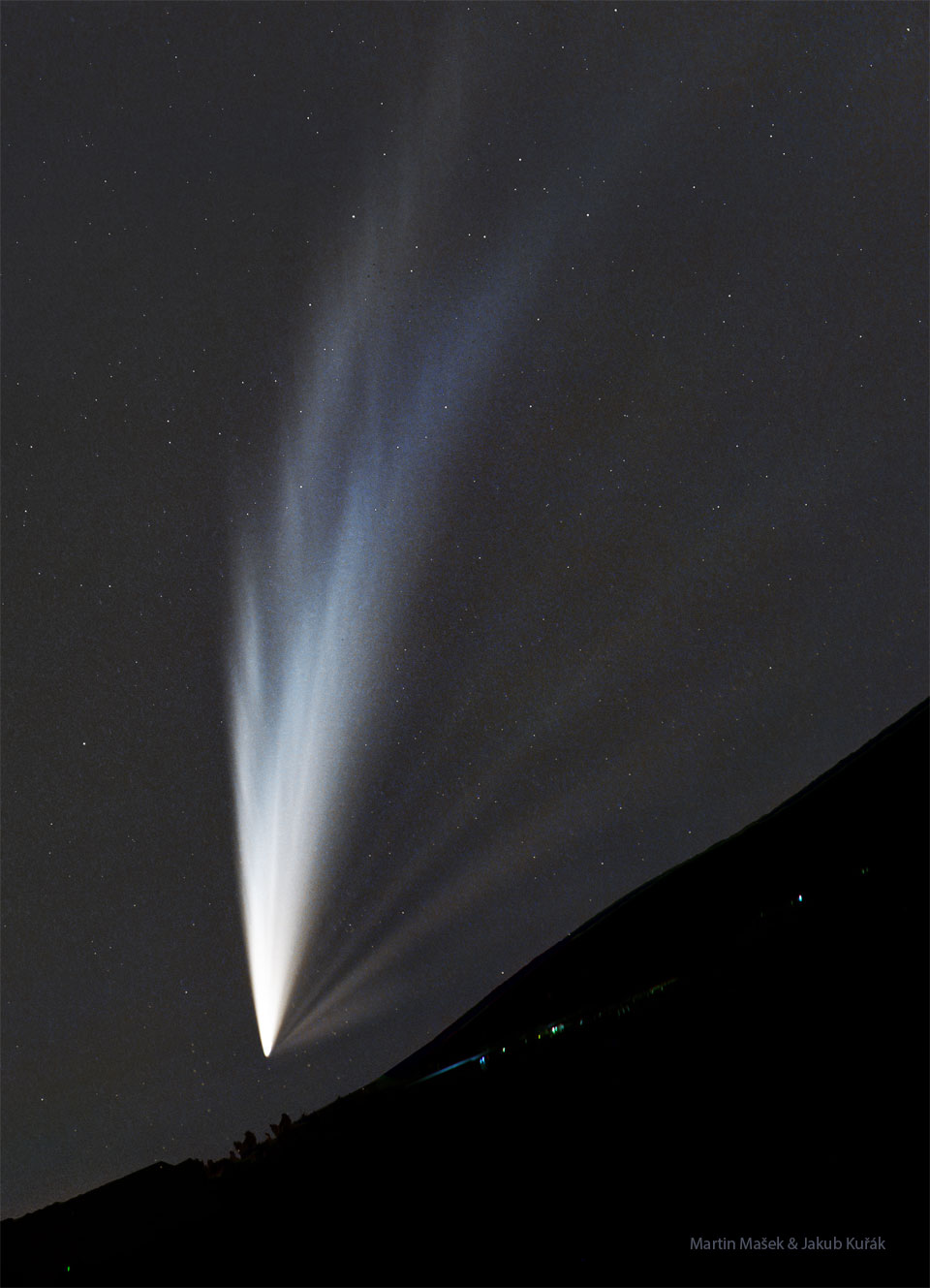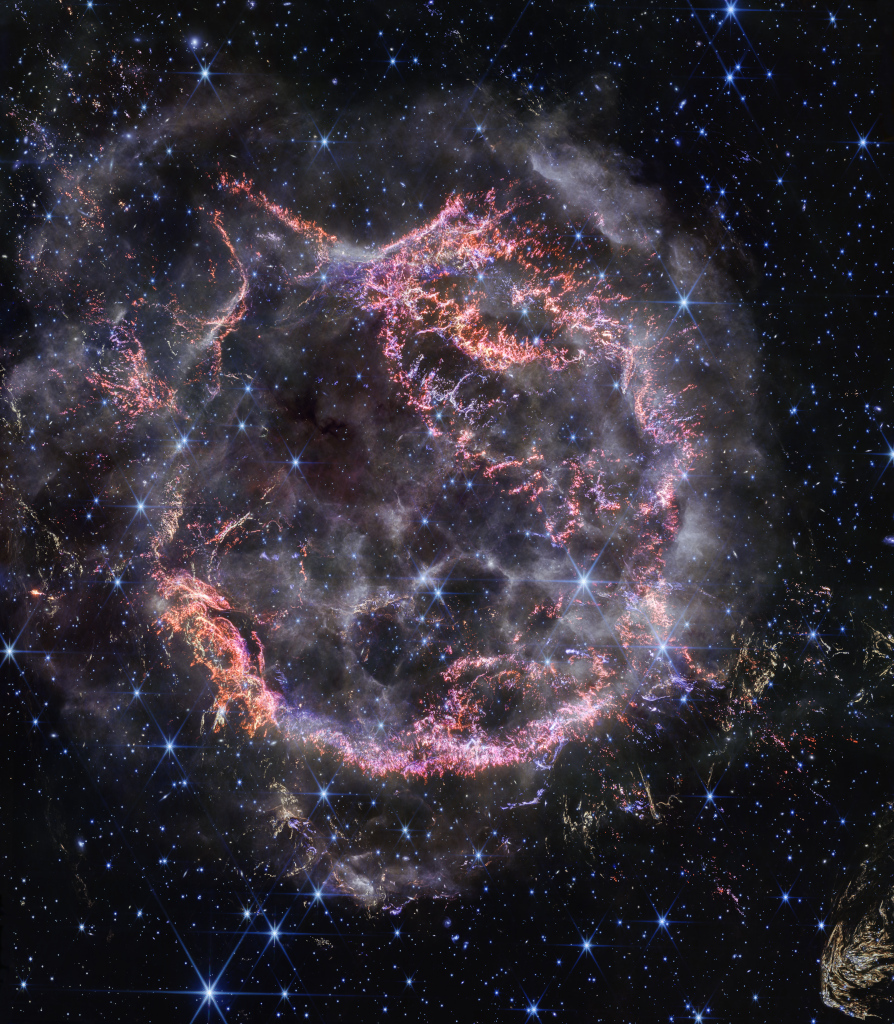Nombre total de pages vues
31/01/2025
AERONAUTIQUE - La grande épopée des ballons dirigeables - 2016 : le dirigeable pentalobé ULM de Voliris
ASTRONOMY - The Variable Nebula NGC 2261
2025 January 31
Image Credit & Copyright: Tommy Lease (Denver Astronomical Society)
Explanation: The interstellar cloud of dust and gas captured in this sharp telescopic snapshot is seen to change its appearance noticeably over periods as short as a few weeks. Discovered over 200 years ago and cataloged as NGC 2261, bright star R Monocerotis lies at the tip of the fan-shaped nebula. About one light-year across and 2500 light-years away, NGC 2261 was studied early last century by astronomer Edwin Hubble and the mysterious cosmic cloud is now more famous as Hubble's Variable Nebula. So what makes Hubble's nebula vary? NGC 2261 is composed of a dusty reflection nebula fanning out from the star R Monocerotis. The leading variability explanation holds that dense knots of obscuring dust pass close to R Mon and cast moving shadows across the dust clouds in the rest of Hubble's Variable Nebula.
SANTé/MEDECINE - Alimentation - Il faut absolument éviter les crêpes industrielles - 2/3 -
30/01/2025
SANTé/MEDECINE - Alimentation - Il faut absolument éviter les crêpes industrielles - 1/3 -
AERONAUTIQUE - La grande épopée des ballons dirigeables - 2016 : Airlander 50 en vue
ASTRONOMY - Hydrogen Clouds of M33
2025 January 30
Image Credit & Copyright: Pea Mauro
Explanation: Gorgeous spiral galaxy Messier 33 seems to have more than its fair share of glowing hydrogen gas. A prominent member of the local group of galaxies, M33 is also known as the Triangulum Galaxy and lies a mere 3 million light-years away. The galaxy's central 60,000 light-years or so are shown in this sharp galaxy portrait. The portrait features M33's reddish ionized hydrogen clouds or HII regions. Sprawling along loose spiral arms that wind toward the core, M33's giant HII regions are some of the largest known stellar nurseries, sites of the formation of short-lived but very massive stars. Intense ultraviolet radiation from the luminous, massive stars ionizes the surrounding hydrogen gas and ultimately produces the characteristic red glow. In this image, broadband data were combined with narrowband data recorded through a filter that transmits the light of the strongest visible hydrogen and oxygen emission lines.
29/01/2025
AERONAUTIQUE - La grande épopée des ballons dirigeables - 2016 : Stratobus relance la filière française du dirigeable
ASTRONOMY - Dust Shells around WR 140 from Webb
2025 January 29
Image Credit: NASA, ESA, CSA, STScI, E. Lieb (U. Denver), R. Lau (NSF NOIRLab), J. Hoffman (U. Denver)
Explanation: What are those strange rings? Rich in dust, the rings are likely 3D shells -- but how they were created remains a topic of research. Where they were created is well known: in a binary star system that lies about 6,000 light years away toward the constellation of the Swan (Cygnus) -- a system dominated by the Wolf-Rayet star WR 140. Wolf-Rayet stars are massive, bright, and known for their tumultuous winds. They are also known for creating and dispersing heavy elements such as carbon, which is a building block of interstellar dust. The other star in the binary is also bright and massive -- but not as active. The two great stars joust in an oblong orbit as they approach each other about every eight years. When at closest approach, the X-ray emission from the system increases, as, apparently, does the dust expelled into space -- creating another shell. The featured infrared image by the Webb Space Telescope resolves greater details and more dust shells than ever before. Images taken over consecutive years show the shells moving outward.
28/01/2025
AERONAUTIQUE - La grande épopée des ballons dirigeables - 2012 : Eurêka - le L-ZNT d’Airship Ventures
ASTRONOMY - Comet G3 ATLAS over Uruguay
2025 January 28
Image Credit & Copyright: Mauricio Salazar
Explanation: Comets can be huge. When far from the Sun, a comet's size usually refers to its hard nucleus of ice and rock, which typically spans a few kilometers -- smaller than even a small moon. When nearing the Sun, however, this nucleus can eject dust and gas and leave a thin tail that can spread to an enormous length -- even greater than the distance between the Earth and the Sun. Pictured, C/2024 G3 (ATLAS) sports a tail of sunlight-reflecting dust and glowing gas that spans several times the apparent size of a full moon, appearing even larger on long duration camera images than to the unaided eye. The featured image shows impressive Comet ATLAS over trees and a grass field in Sierras de Mahoma, San Jose, Uruguay about a week ago. After being prominent in the sunset skies of Earth's southern hemisphere, Comet G3 ATLAS is now fading as it moves away from the Sun, making its impressive tails increasingly hard to see.
27/01/2025
SANTé/MEDECINE - A la découverte de l'oreille - Echelle des niveaux sonores
ASTRONOMY - Pleiades over Half Dome
2025 January 27
Image Credit & Copyright: Dheera Venkatraman
Explanation: Stars come in bunches. The most famous bunch of stars on the sky is the Pleiades, a bright cluster that can be easily seen with the unaided eye. The Pleiades lies only about 450 light years away, formed about 100 million years ago, and will likely last about another 250 million years. Our Sun was likely born in a star cluster, but now, being about 4.5 billion years old, its stellar birth companions have long since dispersed. The Pleiades star cluster is pictured over Half Dome, a famous rock structure in Yosemite National Park in California, USA. The featured image is a composite of 28 foreground exposures and 174 images of the stellar background, all taken from the same location and by the same camera on the same night in October 2019. After calculating the timing of a future juxtaposition of the Pleiades and Half Dome, the astrophotographer was unexpectedly rewarded by an electrical blackout, making the background sky unusually dark.
26/01/2025
AERONAUTIQUE - La grande épopée des ballons dirigeables - 2016 : la Natac de Voliris ou le drone version triple XL
SANTé*MEDECINE - A la découverte de l'oreille - L’implant cochléaire
ASTRONOMY - The Many Tails of Comet G3 ATLAS
2025 January 26
Image Credit & Copyright: Martin Mašek (FZU, Czech Academy of Sciences) & Jakub Kuřák
Explanation: Why does this comet have so many tails? C/2024 G3 (ATLAS) has developed several long and intricate tails visible from Earth's southern hemisphere over the past two weeks. Many observers reported seeing the impressive comet without any optical aid above the western horizon just after sunset. At least six different tails appear in the featured image captured five days ago from the dark skies above Paranal Observatory in Chile. One possible cause for the multiple tails is dust and gas being expelled from the comet's rotating nucleus. The outward push of the Sun's complex solar wind may also play a role. The huge iceberg-like nucleus of Comet ATLAS appears to have broken up near its closest approach to the Sun two weeks ago. Unfortunately, Comet ATLAS and its tails are expected to fade significantly over the coming weeks.
ASTRONOMY - Stardust in the Perseus Molecular Cloud
Image Credit & Copyright: Jeff Schilling
Explanation: Clouds of stardust drift through this deep skyscape, across the Perseus molecular cloud some 850 light-years away. Dusty nebulae reflecting light from embedded young stars stand out in the nearly 4 degree wide field of view. With a characteristic bluish color reflection nebula NGC 1333 is prominent near center. Hints of contrasting red emission from Herbig-Haro objects, the jets and shocked glowing gas emanating from recently formed stars, are scattered across the dusty expanse. While many stars are forming in the molecular cloud, most are obscured at visible wavelengths by the pervasive dust. The chaotic environment surrounding NGC 1333 may be similar to one in which our own Sun formed over 4.5 billion years ago. At the estimated distance of the Perseus molecular cloud, this cosmic scene would span about 80 light-years.
24/01/2025
SANTé/MEDECINE - A la découverte de l'oreille - La trompe d'Eustache
ASTRONOMY - Comet G3 ATLAS: a Tail and a Telescope
2025 January 24
Comet G3 ATLAS: a Tail and a Telescope
Explanation: Comet C/2024 G3 ATLAS has made a dramatic appearance in planet Earth's skies. A visitor from the distant Oort Cloud, the comet reached its perihelion on January 13. On January 19, the bright comet was captured here from ESO Paranal Observatory in the Atacama desert in Chile. Sporting spectacular sweeping dust tails, this comet ATLAS is setting in the southern hemisphere twilight and was clearly visible to the unaided eye. In the foreground is the closed shell of one of the observatory's famous auxiliary telescopes. Still wowing southern hemisphere observers, the comet's bright coma has become diffuse, its icy nucleus apparently disintegrating following its close approach to the Sun.
23/01/2025
SANTé/MEDECINE - A ladécouverte de l'oreille - Le neurinome de l’acoustique
ASTRONOMY - NGC 7814: Little Sombrero
2025 January 23
Image Credit & Copyright: Mike Selby
Explanation: Point your telescope toward the high flying constellation Pegasus and you can find this cosmic expanse of Milky Way stars and distant galaxies. NGC 7814 is centered in the sharp field of view that would almost be covered by a full moon. NGC 7814 is sometimes called the Little Sombrero for its resemblance to the brighter more famous M104, the Sombrero Galaxy. Both Sombrero and Little Sombrero are spiral galaxies seen edge-on, and both have extensive halos and central bulges cut by a thin disk with thinner dust lanes in silhouette. In fact, NGC 7814 is some 40 million light-years away and an estimated 60,000 light-years across. That actually makes the Little Sombrero about the same physical size as its better known namesake, appearing smaller and fainter only because it is farther away.
22/01/2025
SANTé/MEDECINE - A la découverte de l'oreille - Étrier droit - vue antérieure
ASTRONOMY - The North America Nebula
Image Credit & Copyright: Dimitris Valianos
Explanation: The North America nebula on the sky can do what the North America continent on Earth cannot -- form stars. Specifically, in analogy to the Earth-confined continent, the bright part that appears as the east coast is actually a hot bed of gas, dust, and newly formed stars known as the Cygnus Wall. The featured image shows the star forming wall lit and eroded by bright young stars and partly hidden by the dark dust they have created. The part of the North America nebula (NGC 7000) shown spans about 50 light years and lies about 1,500 light years away toward the constellation of the Swan (Cygnus).
21/01/2025
AERONAUTIQUE - La grande épopée des ballons dirigeables - 2010 : le ballon captif de surveillance 101230-N-0020T-144
SANTé/MEDECINE - A la découverte de l'oreille - L'oreille interne
ASTRONOMY - Comet ATLAS over Brasília
2025 January 21
Image Credit: Frederico Danin
Explanation: What's that in the sky? Above the city, above most clouds, far in the distance: it's a comet. Pictured, the impressive tail of Comet C/2024 G3 (ATLAS) was imaged from Brasília, Brazil four days ago. Last week the evolving comet rounded the Sun well inside the orbit of planet Mercury, going so close there was early concern that it might break up -- and recent evidence that it really did. At one point near perihelion, Comet ATLAS was so bright that sightings were even reported during the day -- over the bright sky near the Sun -- by careful observers. Over the past few days, Comet ATLAS has developed a long tail that has been partly visible with unaided eyes after sunset, most notably in Earth's southern hemisphere.
20/01/2025
ASTRONOMY - Comet ATLAS Rounds the Sun
2025 January 20
Image Credit: NASA, SOHO Spacecraft, LASCO C3; Processing: Rolando Ligustri
Explanation: Why does Comet ATLAS have such colorful tails? Last week Comet C/2024 G3 (ATLAS) passed its closest to the Sun -- well inside the orbit of Mercury -- and brightened dramatically. Unfortunately, the comet was then so angularly near the Sun that it was very hard for humans to see. But NASA's SOHO spacecraft saw it. Pictured is a SOHO (LASCO C3) image of Comet ATLAS that is a composite of several different color filters. Of the several tails visible, the central white tails are likely made of dust and just reflecting back sunlight. The red, blue, and green tails are likely ion tails with their colors dominated by light emitted by specific gases that were ejected from the comet and energized by the Sun. Currently, Comet ATLAS is showing long tails in southern skies but fading as it moves out of the inner Solar System.
19/01/2025
SANTé/MEDECINE - A la découverte de l'oreille - Les osselets dans l'oreille
ASTRONOMY - Titan Touchdown: Huygens Descent Movie
2025 January 19
Video Credit: ESA, NASA, JPL, U. Arizona, E. Karkoschka
Explanation: What would it look like to land on Saturn's moon Titan? The European Space Agency's Huygens probe set down on the Solar System's cloudiest moon in 2005, and a time-lapse video of its descent images was created. Huygens separated from the robotic Cassini spacecraft soon after it achieved orbit around Saturn in late 2004 and began approaching Titan. For two hours after arriving, Huygens plummeted toward Titan's surface, recording at first only the shrouded moon's opaque atmosphere. The computerized truck-tire sized probe soon deployed a parachute to slow its descent, pierced the thick clouds, and began transmitting images of a strange surface far below never before seen in visible light. Landing in a dried sea and surviving for 90 minutes, Huygen's returned unique images of a strange plain of dark sandy soil strewn with smooth, bright, fist-sized rocks of ice.
18/01/2025
ASTRONOMY - Full Moon, Full Mars
2025 January 18
Image Credit & Copyright: David Bowman
Explanation: On January 13 a Full Moon and a Full Mars were close, both bright and opposite the Sun in planet Earth's sky. In fact Mars was occulted, passing behind the Moon, when viewed from some locations in North America and northwest Africa. As seen from Richmond, Virginia, USA, this composite image sequence follows the evening lunar occultation before, during, and after the much anticipated celestial spectacle. The telescopic time series is constructed from an exposure made every two minutes while tracking the Moon over the hours encompassing the event. As a result, the Red Planet's trajectory seems to follow a gently curved path due to the Moon's slightly different rate of apparent motion. The next lunar occultation of bright planet Mars will be on February 9 when the moon is in a waxing gibbous phase. Lunar occultations are only ever visible from a fraction of the Earth's surface, though. The February 9 occultation of Mars will be seen from parts of Russia, China, eastern Canada, Greenland and other (mostly northern) locations, but a close conjunction of a bright Moon with Mars will be more widely visible from planet Earth.
17/01/2025
SANTé/MEDECINE - Cancer du poumon - L'importance d'un diagnostic précoce - 2/2 -
SANTé/MEDECINE - Cancer du poumon : un signe précoce - 1/2 -
ASTRONOMY - Supernova Remnant Cassiopeia A
Image Credit: NASA, ESA, CSA, STScI; D. Milisavljevic (Purdue University), T. Temim (Princeton University), I. De Looze (University of Gent)
Explanation: Massive stars in our Milky Way Galaxy live spectacular lives. Collapsing from vast cosmic clouds, their nuclear furnaces ignite and create heavy elements in their cores. After only a few million years for the most massive stars, the enriched material is blasted back into interstellar space where star formation can begin anew. The expanding debris cloud known as Cassiopeia A is an example of this final phase of the stellar life cycle. Light from the supernova explosion that created this remnant would have been first seen in planet Earth's sky about 350 years ago, although it took that light 11,000 years to reach us. This sharp NIRCam image from the James Webb Space Telescope shows the still hot filaments and knots in the supernova remnant. The whitish, smoke-like outer shell of the expanding blast wave is about 20 light-years across. A series of light echoes from the massive star's cataclysmic explosion are also identified in Webb's detailed images of the surrounding interstellar medium.
16/01/2025
AERONAUTIQUE - La grande épopée des ballons dirigeables - 2010 : le ballon captif de surveillance 101230-N-0020T-144
ASTRONOMY - Orion and the Ocean of Storms
2025 December 13 Orion and the Ocean of Storms Image Credit: NASA , Artemis 1 Explanation: On December 5, 2022, a camera on board the u...

-
2022 September 26 All the Water on Planet Earth Illustration Credit: Jack Cook, Adam Nieman, Woods Hole Oceanographic Institution ; Data ...
-
2025 May 11 The Surface of Venus from Venera 14 Image Credit: Soviet Planetary Exploration Program , Venera 14 ; Processing & Copyri...


































